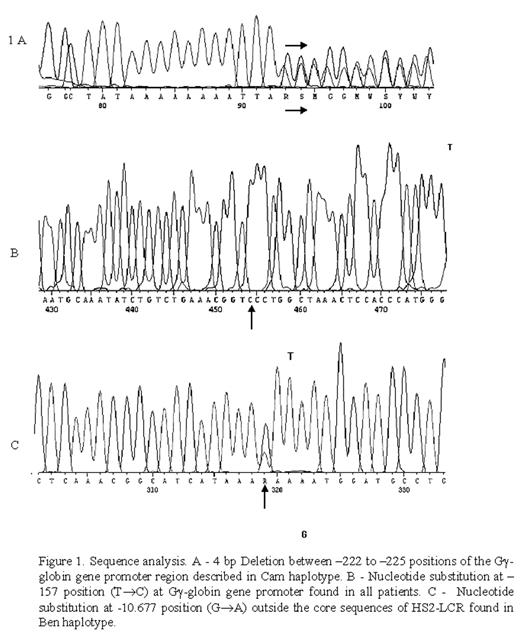Abstract
The sickle cell anemia has a very high prevalence in Bahia, a state of Brazil. The HbF levels and bS-globin gene haplotypes of 125 sickle cell anemia patients were investigated and the Gγ and Aγ gene promoter and HS2-LCR regions of ten patients were selected for DNA sequence. The study was approved by the Oswaldo Cruz Research Foundation’s human research ethics committee. The bS- globin gene haplotypes were investigated using polymerase chain reaction (PCR) and restriction fragment length polymorphism (RFLP) techniques; the HbF levels were estimated by high performance liquid chromatography (HPLC). The Gg and Ag-globin gene promoter and HS2-LCR regions were sequenced in an automatic sequencer. The distribution of bS- globin gene haplotypes showed 64 (51.2%) patients with genotype CAR/Ben; 36 (28.8%) Ben/Ben; 18 (14.4%) CAR/CAR; two (1.6%) CAR/Aty; two (1.6%) Ben/Cam; one (0.8%) Car/Cam; one (0.8%) CAR/Arab-India and one (0.8%) Sen/Aty. Among these patients, four CAR/CAR had HbF ≥10.0%; three Ben/Ben had HbF ≤ 5.0%; 11 CAR/Ben had HbF ≥15.0% and 18 had HbF ≤ 5.0%; two Cam/Ben patients had HbF levels ≥15.0%. Ten individuals presenting HbF and bS-globin gene haplotypes diversity were selected to sequence the Gg and Ag-globin gene promoter and HS2-LCR regions. The HS2-LCR sequence analyses demonstrated a G→A change (−10.677) (GeneBank DQ873522) in five sickle cell anemia patients with Ben haplotype and high HbF levels (Table 1); the CAR/Ben and Ben/Ben patients with low HbF levels did not have this sequence variation; among the small patient group investigated, there were two CAR/CAR patients with high HbF levels without this substitution. The Gg gene promoter sequence analyses showed a T→C substitution (−157) (GeneBank DQ873521) among all patients and a 4 bp deletion (−222 to −225) (GeneBank DQ873519) related to Cam haplotype (Figure 1). The HS2-LCR sequence change reported here is located in the proximity to a binding site of the GATA-1 and a ubiquitous trans-acting factor and can constitute a motif associated to the Ben chromosome and may play an important role in g-globin gene transcription regulation. The polymorphic site on Gg-globin gene promoter region can be a common sequence characteristic among the Brazilian sickle cell anemia patients. The results described here suggest new polymorphisms in the HS2-LCR and Gg gene promoter and confirms the genotypic heterogeneity among Brazilian sickle cell anemia patients, justifying further studies to investigate its correlation with HbF synthesis and clinical profile in sickle cell anemia patients.
Disclosure: No relevant conflicts of interest to declare.
Author notes
Corresponding author


This feature is available to Subscribers Only
Sign In or Create an Account Close Modal